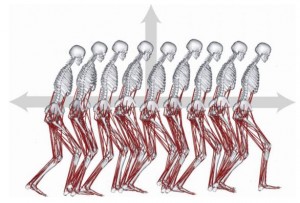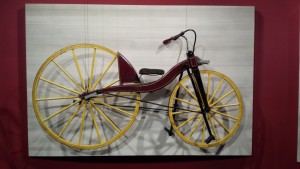Interested in Biomechanics?
The Mechanical Engineering Department at UW offers a broad array of courses and research labs focused around biomechanics – from the microscale of proteins and cells (e.g., Cell Biomechanics Lab) to macroscale investigations of movement and performance, such as in our lab. Undergraduate students in mechanical engineering can pursue a Biomechanics Option.
Please see the list of Biomechanics Courses.
Winter Quarter: ME419/519 Biomechanics Seminar
Representatives from research, industry, and local hospitals share novel biomechanics discoveries and applications. If you are interested in speaking and sharing your work, please contact Dr. Steele.
ME412/512 Biomechanics of Movement
 The objective of this course is to provide students with an overview of the major challenges in movement biomechanics and experience with the engineering tools we use to address these challenges. We achieve this objective through lectures, hands-on laboratories, homework problems, simulation exercises, and student research papers and presentations. Our specific learning objectives for the course are to prepare students who can:
The objective of this course is to provide students with an overview of the major challenges in movement biomechanics and experience with the engineering tools we use to address these challenges. We achieve this objective through lectures, hands-on laboratories, homework problems, simulation exercises, and student research papers and presentations. Our specific learning objectives for the course are to prepare students who can:
- Describe the biological, mechanical, and neurological mechanisms by which muscles
produce movement, - Identify and use engineering tools that are used to study movement,
- Write and solve equations of motion for simple models of human movement,
- Apply biomechanics principles to “real-world” clinical and biomechanical research.
Syllabus from prior course.
Interested in Design?
ENGR297/497 HuskyADAPT: Accessible Design & Play Technology
HuskyADAPT is both a Vertically-Integrated Project Design Course through the College of Engineering and a Student Organization. Our group was co-founded by our lab, the Taskar Center for Accessible Technology, and Bioengineering Outreach.
In the two-quarter design course, students work on multidisciplinary teams with local individuals with disabilities to address pressing needs related to accessibility, movement, and play. VIP courses are designed to provide students with hands-on, project-based, research and design experiences. By the end of the course, we aim for students to be able to:
- Follow participatory design best practices
- Describe the history of people with disabilities in the US, including social, environmental, and design barriers faced
- Understand introductory principles of disability studies and how they relate to engineering practice
- Engage in and evaluate the co-design process with community members with disabilities
- Identify the principles of inclusive design and how they benefit diverse communities
- Devise an action plan to promote inclusivity and accessibility in engineering practice
To learn more, please see the ENGR 497 Syllabus.
Engineering Innovations in Health
Engineering Innovations in Health is a year-long program in the UW College of Engineering to work on design challenges that enhance human health and well-being. Undergraduate and graduate students work in teams of 3-5 students with a clinical partner to design, build, and test prototypes. Our specific learning objectives for the course are to prepare students who can:
- Demonstrate excellence in design and testing methodology,
- Work in multidisciplinary teams at the interface between engineering and medicine, and
- Create cost-effective and innovative solutions to pressing clinical needs.
Past projects include techniques to improve neonatal intubation, development of open-source platforms for measuring capillary refill time in the developing world, designing a passive pediatric exoskeleton, and preventing pneumothorax during lung biopsies.
Learn more about past projects!
Have an idea for a project? We accept proposals each summer from local clinical partners. If you would like to submit an idea for a project, please complete our proposal form.
Additional Engineering Courses
ME460 Kinematic Analysis and Synthesis
 This course introduces students to the concepts of kinematics, kinematic analysis (including position, velocity, and acceleration), and linkage design (for two and three position motion, path and function generation). Students will learn to use both graphical and computer techniques for analysis and synthesis of kinematic systems. At the end of this course the student should be able to:
This course introduces students to the concepts of kinematics, kinematic analysis (including position, velocity, and acceleration), and linkage design (for two and three position motion, path and function generation). Students will learn to use both graphical and computer techniques for analysis and synthesis of kinematic systems. At the end of this course the student should be able to:
- Model real mechanisms for mobility, position, velocity, and acceleration
- Design linkages for rigid-body guidance, rocker amplitude, path generation, and function generation
- Analyze and design cam/follower mechanisms
- Use both graphical and analytical approaches to mechanism analysis
Syllabus from prior course.


